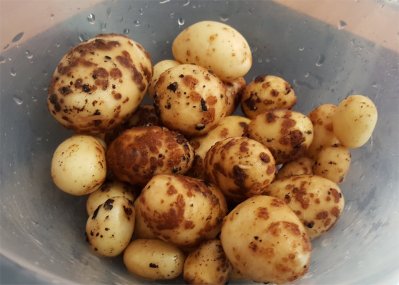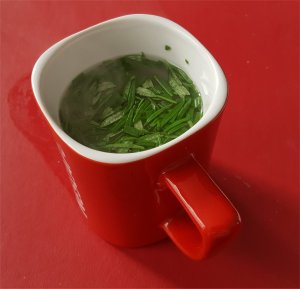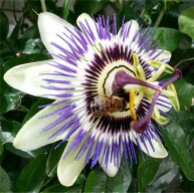 Well week three has been a much more enjoyable week. I think the sunshine and 25°+ temperatures have helped raise the mood.
Well week three has been a much more enjoyable week. I think the sunshine and 25°+ temperatures have helped raise the mood.
With a bit of forward thinking I was also able to plan my posts and managed to gather enough photographs and subjects to hopefully make the post more informative. Let me know your thoughts.
Day Fifteen: Thursday.
Last year I didn’t have much luck with growing my own vegetables. I tried growing peppers, green beans, spring onions and tomatoes. All perished. The only success of the summer was the maris bard potatoes, and I got two harvests from them!
So this spring I decided to get the same variety in the hope of getting a bumper harvest of gorgeous new-potato-type earlies. However, ‘the best laid plans of mice and men often go awry’. I planted the chits in March/April and waited for the plants to grow and the flowers to appear. This year nothing happened, save the plants in the grow bag yellowed and some died. I watered them during the dry spell and decided on Thursday to rummage in the soil to see if there were any potatoes grown. There were, but they all looked like this!

I was so upset! What had happened to my lovely potatoes? After doing some reading online I found there could be a number of reasons my potatoes looked like they had acne.
- The spots could be a nematode, or microscopic worm.
- There was a lack of moisture in the soil during hot weather.
- The spots could be early blight, a fungus spread by rain and hot temperatures.
- Probable potato scab which is a bacterium.
I suppose you only learn as a gardener if you make an attempt at growing. Perhaps last years harvest was a fluke? I have centurion onions growing in a bag too. I wonder what they will look like come harvesting?
Have you had a diseased riddled harvest? Let me know your stories.
Day sixteen: Friday.
All week, our female blue-faced parrot finch (Forrest) has been laying tiny white eggs. This got me thinking, how is an egg actually made? So I did a little research.
The egg as we know it is assembled inside out! The yolk comes first and is released via the oviaries. Fertilisation (if applicable) occurs once the yolk is released. The yolk then passes along the oviduct where the albumen and membranes are created. Calcification occurs at the shell gland and this produces the egg shell. Shell production can take up to 20 hours and the whole process lasts around 24 hours!
If you are interested to know more, then follow this link here, and here, and here.
Day Seventeen: Saturday.
Two of random acts of wildness are: 1. grow borage for bees and 2. take a picture of something blue.

Since 2015, when I began participating in 30 Days Wild, I have grown borage for bees. This year has been no different. I harvested the seeds from last years plants and sowed them this spring. Right on cue for June the new plants have begun flowering. The bees love them and they are also my something blue for 2017!
Day Eighteen: Sunday.
Having never picked our own fruit before I was very excited to try! I found a local farm, Claremont, on the Wirral, who have a pick your own season. So David and I visited this weekend. On arrival we opted for two small punnets and headed towards the field where hundreds of strawberry plants were growing. The farm was very busy with families. We chose our row and began foraging among the strawberry plants. We found big juicy fruit, the smell was delicious!
Having filled our punnets to the brim we took them to the farmer who weighed the harvest and the cost was £6 for the two punnets. I thought it was reasonable, with the guarantee that the fruit is fresh having picked them straight from the plant. We will definitely visit again.
Have you picked your own? What fruit do you prefer?
Day Nineteen: Monday.
Nicky at Too Lazy to Weed wrote a wonderful blog about plant pots for pollinators an initiative by Butterfly Conservation. They offer a planting guide for beginners and ask for participants to log their pots on a map and state what plants you have for pollinators. I have numerous pots and plants for pollinators so it wasn’t difficult to participate in.
Here are a few pictures of some of the plants I have in the yarden for pollinators.
Some pollinator friendly plants are:
- Hellebore
- Chives
- Lavender
- Honeysuckle
- Sunflower
- Michaelmas Daisies
Perhaps you can plant a pot for pollinators and help out our hungry insects?
Day Twenty: Tuesday.
I’ve decided to showcase two bees who have been seen visiting the yarden. 1. the leaf-cutter bee and 2. the honey bee.
- One of the solitary bees.
- Nests in cavities.
- So named due to cutting out leaves to make their ‘cells’ for larvae.
- On the wing April to August.
- Feeds on nectar and pollen which they carry on their abdomen.
- Are hive bees and live in colonies.
- A colony can be between 35,000 to 60,000 bees.
- The hive is structured with a queen, worker bees (females) and drones (males).
- Prefer simple, open flowers.
- Carry their pollen in baskets on their hind legs.
Day Twenty-one: Wednesday.
The Summer Solstice. Last year I got up at 4 am and listened to the dawn chorus. This year since having a long day at work, (and I mean a loooong day at work). I decided to look for alternative ways of celebrating the solstice.
Solstice is the Latin for ‘sun seems to stand still.’ Some see the solstice as the beginning of summer, whereas others see it as midsummer. The sun is at its most northerly position (and at winter it’s the most southerly). The solstice occurs due to the tilt of the Earth at 23.5°. In summer the Earth is tilting towards the sun and for the UK the summer solstice means approx. 16 hours of sunlight, the longest day. During the winter solstice the opposite occurs (approx. 8 hours of sunlight), meaning the shortest day.
Thought.co have some good ideas on how to celebrate the summer solstice.
WikiHow suggests doing some sky observations.
I can’t remember where I saw it now, but I read that making a herbal brew was also a way of celebrating the solstice, so I decided on attempting a rosemary tea.

Rosemary Tea
Rosemary is full of antioxidants (supports the immune system), has vitamins A and C and is helpful in boosting memory. Shakespeare in Hamlet, (act four, scene five,) has Ophelia saying (in her maddened state), ‘there’s rosemary, that’s for remembrance. Pray you, love, remember.’ It can also aid relaxation, ease anxiety and help digestion. So I thought I would give it a try.
Ingredients (makes one small mug):
- I used two tablespoons of finely chopped fresh rosemary leaves (cut fresh from the yarden).
- One cup of boiled water or 250ml.
- Leave to steep for 5 to 10 minutes.
- Strain and drink.
My thoughts:
I decided to drink the infusion whilst listening to Mendelssohn’s A Midsummer Night’s Dream, based of the William Shakespeare play. I listened as a muggy day turned to a cooler evening.
The infusion created a green tea. Rosemary is a very aromatic herb and the tea was very florally. I think I preferred the music to the drink.
What is your favorite herbal drink?
Summary:
What a diverse week, week three has been! From failed potato harvests to gorgeous strawberries! I have tried to share new experiences and facts I’ve learned.
What random acts of wildness have you enjoyed doing this week?
A Look Back:
2015: Bees and growing borage.
2016: Wild swimming and birds.
Thanks for dropping by,
Christine x













A very informative post.
Looks like you are getting a good number of bees in your yarden. I remember making a borage lemonade when I did 30 says Wild in 2015. I’m not sure I would like rosemary tea either, but the strawberry picking looks like fun. X
LikeLiked by 1 person
A really interesting and informative week! I had a really long day at work yesterday too, but I drank silver birch wine in the garden at around 9pm for my Solstice wildness! Better than nothing.
LikeLiked by 1 person
Silver birch wine, now that sounds interesting!! 🙂 x
LikeLike
Really interesting, I often wondered about eggs but never found out, thanks for this! A lovely post. I adore fruit picking. I don’t like herbal teas!
LikeLiked by 1 person
I don’t like herbal teas either lol x
LikeLike
What a lovely varied week you had! How’s your elderflower champagne coming along? Mine (made using your recipe!) is in a big plastic bottle that’s all swollen now, so I guess it must be fermenting – hope it doesn’t explode! x
LikeLiked by 1 person
My champagne is fermenting too. So I must have done something right! 🙂 I keep loosening the tops to let out a little of the gas. The bottles fill with bubbles quickly! I was letting my mum have a smell of the gas the other day and the top shot off, so be careful when opening yours! I’m going to have a glass on the last day of 30 days. I don’t know what to expect as I’ve never drank elder-flower champagne before. I look forward to how yours turns out too 🙂 x
LikeLike
Camomile and honey tea
I like lots of herbal and Chinese teas
Midsummer Nights opera is fab choice
LikeLiked by 1 person
I didn’t have any chamomile flowers so made do with rosemary. I could have tried lavender or oregano tea.
LikeLiked by 1 person
Good choices
If you’re ever feeling run down with a head cold try the Chinese tea, it’s like a nut that expands into slime with hot water, looks disgusting but it’s good
LikeLiked by 1 person
Thanks for the tip Charlotte x
LikeLiked by 1 person